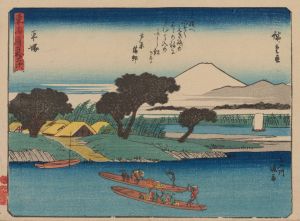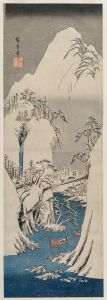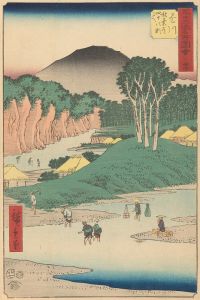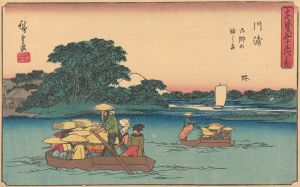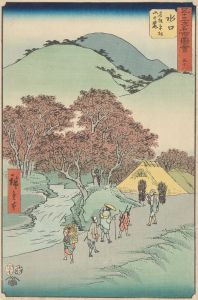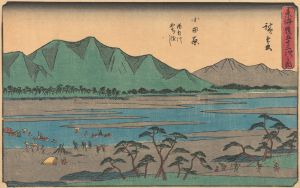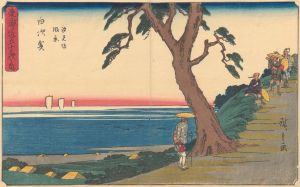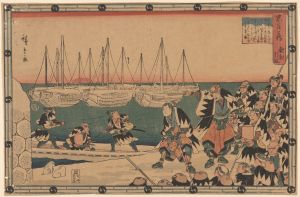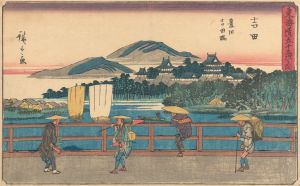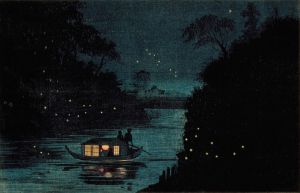
Ishibe
A hand-painted replica of Andō Hiroshige’s masterpiece Ishibe, meticulously crafted by professional artists to capture the true essence of the original. Each piece is created with museum-quality canvas and rare mineral pigments, carefully painted by experienced artists with delicate brushstrokes and rich, layered colors to perfectly recreate the texture of the original artwork. Unlike machine-printed reproductions, this hand-painted version brings the painting to life, infused with the artist’s emotions and skill in every stroke. Whether for personal collection or home decoration, it instantly elevates the artistic atmosphere of any space.
Andō Hiroshige, a renowned Japanese ukiyo-e artist of the Edo period, is celebrated for his landscape prints and series that capture the essence of Japan's natural beauty and daily life. One of his notable works is "Ishibe," which is part of the series "The Fifty-three Stations of the Tōkaidō" (Tōkaidō Gojūsan-tsugi no Uchi). This series is among Hiroshige's most famous and was created following his journey along the Tōkaidō road, a vital route connecting Edo (modern-day Tokyo) to Kyoto.
"The Fifty-three Stations of the Tōkaidō" series, produced in the early 1830s, consists of 55 prints, including the starting point at Nihonbashi in Edo and the terminus at Kyoto, as well as the 53 post stations along the way. Each print in the series depicts a different station, showcasing the unique characteristics and scenery of the location. Hiroshige's work is distinguished by its vibrant colors, dynamic compositions, and the ability to convey the atmosphere of the places he illustrated.
"Ishibe" is the 52nd station in the series and is located in present-day Shiga Prefecture. The print captures the tranquil and rural setting of Ishibe, which was known for its inns and tea houses that provided rest for travelers along the Tōkaidō. Hiroshige's depiction of Ishibe is characterized by its serene landscape, featuring travelers and locals going about their daily activities, set against a backdrop of lush greenery and distant mountains.
Hiroshige's work on the Tōkaidō series was revolutionary in its approach to landscape art. Unlike previous ukiyo-e artists who focused primarily on portraits of courtesans and actors, Hiroshige brought attention to the beauty of Japan's natural landscapes and the experiences of ordinary people. His prints often included elements of humor and human interest, capturing moments of interaction between travelers and the local environment.
The "Ishibe" print, like others in the series, reflects Hiroshige's keen observation and ability to convey a sense of place. His use of perspective and composition draws the viewer into the scene, creating a sense of movement and life. The attention to detail in the depiction of clothing, architecture, and natural elements adds to the authenticity and charm of the work.
Hiroshige's "The Fifty-three Stations of the Tōkaidō" series, including the "Ishibe" print, had a significant impact on both Japanese and Western art. The series was widely popular in Japan and influenced many artists, including those of the Impressionist movement in Europe. Hiroshige's innovative use of color and composition inspired artists such as Vincent van Gogh and Claude Monet, who admired the simplicity and elegance of his work.
In summary, Andō Hiroshige's "Ishibe" is a quintessential example of his mastery in ukiyo-e landscape prints. It captures the essence of a specific location along the historic Tōkaidō road, offering a glimpse into the travel culture of Edo-period Japan. Through his art, Hiroshige not only documented the physical journey along the Tōkaidō but also conveyed the emotional and cultural experiences of the travelers, leaving a lasting legacy in the world of art.





